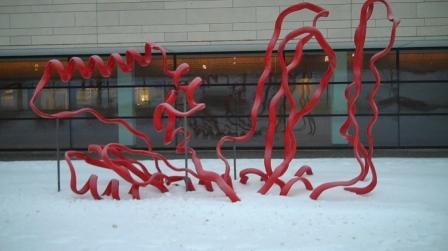Transgenic plants have been with us for well over a decade now. I have had the opportunity to work with many of the tools used for this technology, though most of that is far behind me (over 15 years now since I “ran a gel”) — I’m much happier being outside or even in front of a computer writing than in a lab. Fortunately I have a number of “lab rat” colleagues so I’m relatively up to date on what’s going on and what “gene-jumper” scientists can and can’t do.
To make a long story short, over these years transgenic plants have proven to be useful in some cases (by reducing the use of certain dangerous pesticides), and concerning in others (because some genes have escaped cultivation). I’m not going to go into the crazy ins and outs of the benefits and drawbacks of genetic engineering here except to give you my general opinion which is that every case needs to be handled individually. I do not believe that this engineering is, in and of itself, a bad thing. That said, I do believe that genetic engineering could get us into trouble if we’re not careful.So, with that little disclaimer I thought I’d mention something that I question — I’m not going to call it bad — but maybe it is. There’s an “artist” at the University of Minnesota — Eduardo Kac, who had some of his genetic material placed into a petunia so that some of the proteins from his body were expressed along with the petunias. I don’t have a picture of the petunia itself, but here on the St. Paul campus of the University of Minnesota you can see this structure, created by Kac, which is a graphic representation of a protein from the petunia.

(It was around 20 degrees outside when I took this shot — positively balmy compared to what it’s been like).
Anyway — as I said above — Though I have some concerns, I’m not opposed to using biotechnology for the “good of man.” Nor am I afraid that Kac’s creation is dangerous — from what I know it was kept in a closed system and the petunia was ultimately destroyed — not that it would have been particularly dangerous even if it had been released. But….to me anyway….This seems like a frivolous use of a powerful tool (that tool being the ability to move genes from one organism to another). I don’t know if I’d call it bad….but the words Wasteful and Inappropriate come to mind.
By the way, though I know less about it, it seems that Kac also transferred genes into a rabbit for the sake of art. But this is, after all, a horticulture blog so I thought I’d stick with plants!
I agree, Jeff, and especially from the perspective of being at a public university, where people would legitimately question the use of state resources for this purpose. Like many other states, Washington continues to cut public funding of its state universities, and this just adds fuel to the fire.
Interesting use of genetic engineering. I agree that it seems totally frivolous and certainly could add to some people’s opposition to the use of a tool which has such potential for the good of mankind.
Well, his art got you talking, right? And I would say there is some art that getting conversations started is the point. He would have failed if you had ignored the whole deal.
Normally, @Foy, I might agree with you – but non-tenured people are losing their jobs as higher education programs are being eliminated (and not just “generic” people, but people I know personally). I doubt they would be terribly sympathetic to this use of state resources.
Having the tools to do something doesn’t mean it should be done.